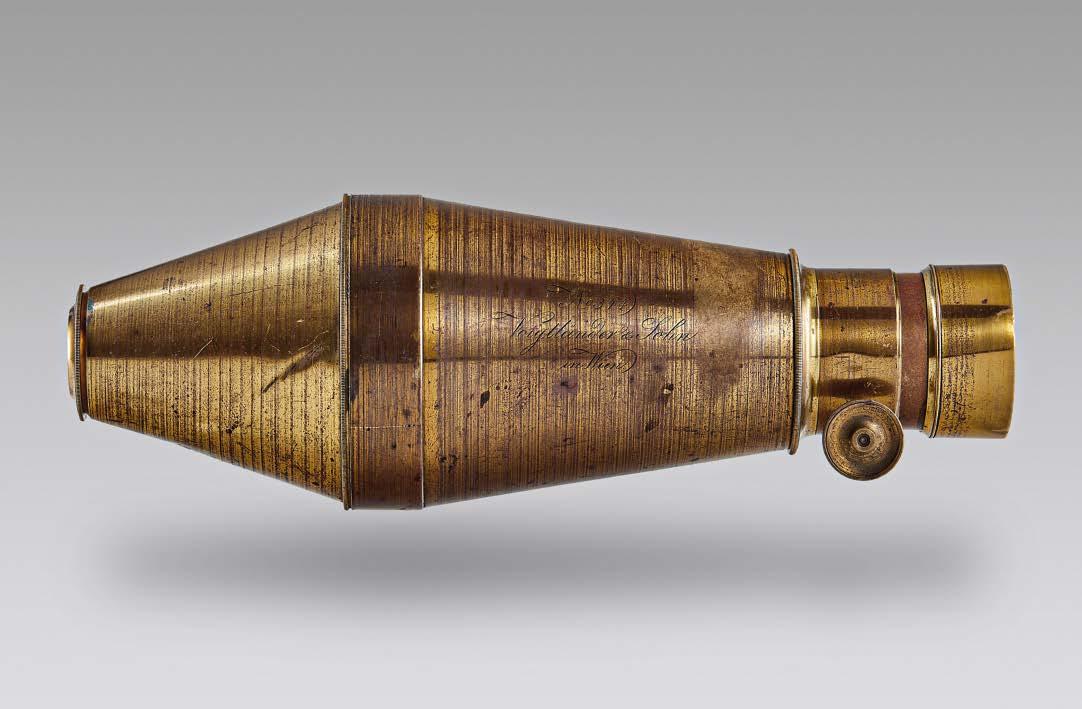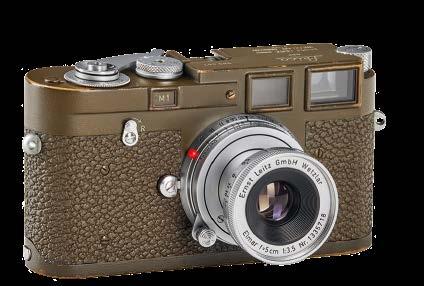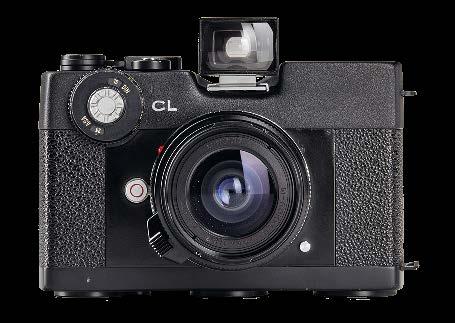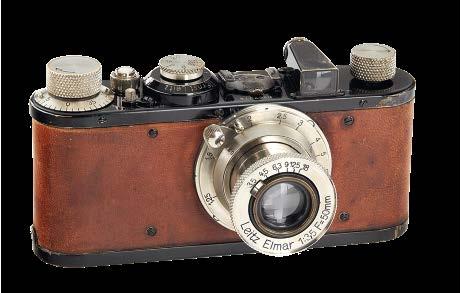
8 minute read
LEITZ AUCTION
RARITIES & CURIOSITIES
37TH LEITZ PHOTOGRAPHICA AUCTION
A daguerreotype camera from the year 1840, a Leica Gun Rifle, and a previously unknown prototype of the Leica CL – these are just some of the auction highlights that will make collectors’ hearts beat faster this November.
On November 21, 2020, the 37th Leitz Camera Auction takes place at the Hotel Bristol in Vienna. As always, the auction catalogue includes a number of especially rare treasures – some of which we shall introduce here. At the time of writing, new consignments are still being accepted. However, at this stage it seems fairly certain that the most expensive auction lot will be a camera that did not originate in Wetzlar.
DAGUERREOTYPIE CAMERA. Louis Daguerre (1787–1851) was not the first person to carry out photographic experiments. However, on August 19, 1839, the physicist François Arago presented the French artist’s technique, the daguerreotype, at a joint meeting of the Parisian Academies of Sciences and Fine Arts. Since then, this day has been considered to mark the birth of photography. Just one year later, the Viennese company founded by Johann Christoph Voigtländer in 1756 (which produced optical instruments, among others) released a daguerreotype camera. This was the first camera to feature an all-metal body and a mathematically calculated lens. Under the leadership of Johann Christoph’s grandson, Peter Wilhelm Friedrich (1812–1878), Voigtländer was also the first company to manufacture Petzval lenses, which were based on the calculations of German-Hungarian mathematician, Joseph Maximilian Petzval (1807–1891). With their maximum aperture of 3.7, they were around 15 times faster than the lenses Daguerre used in his own constructions – thereby enabling exposure times of under a minute. Of the reportedly 600 cameras sold up until 1842, only ten are known to exist today. The autumn auction marks the first time a camera of this type – representing one of the most important milestones in the history of photography – is offered in a public auction. The estimated sale price is 200 000 to 300 000 euros.
LEICA I “CALFSKIN”. Only 180 units of the Leica I (Model C Standard) with a light calfskin trim were produced in 1930/31. In many cases, the leather coverings became worn and were replaced at the Leitz factory with regular vulcanite trims – making an original calfskin Leica an extreme rarity. The offered model (#67074) from the year 1931 is expected to be auctioned for 32 000 to 36 000.
LEICA GUN RIFLE. In 1938 E. Leitz, Inc. New York launched the Leica Gun Rifle, one of the rarest and most unusual Leica accessories ever made. It was produced for only one year (1938/39). Inspired by Attilio Gatti – an Italianborn explorer known for his numerous African expeditions – the ‘rifle camera’ was developed by E. Leitz, Inc. between 1935 and 1937, and introduced to the public in July 1938. Leitz Photographica Auction believe that only 12 to 14 Gun Rifles still exist in various collections worldwide. The offered unit was manufactured in 1938, and is in excellent original condition. →
The Leica M2 with Summicron 50 f/2 previously owned by the conceptual artist Sarkis Daguerreotype camera produced by Voigtländer in 1840 with the world’s first mathematically calculated lens. With its maximum aperture of 3.7, it enabled exposures of under a minute


Leica rarity for wildlife photographers: the Leica Gun Rifle from 1938


Previously unknown prototype of the Leica CL from the early 1970s

Rare olive-green M1 with MP top plate and “Bundeseigentum” engraving
Leica I (Model C Standard) with calfskin trim, produced in 1931

The last Leica M5 ever made – assembled from old stock components in 1992 The set is comprised of a modified Leica IIIa (#230908) from 1937 with a specialist viewfinder (#117), a Telyt 20cm f/4.5, and an extremely rare camera bag (RIFUN). The auction estimate is between 200 000 and 250 000 euros.

LEICA M1 “BUNDESEIGENTUM”. The Leica M1 “Bundeseigentum” (#980467) from 1961 is one of approximately 200 German Military-issued cameras with an olive green, coarsely patterned vulcanite trim. Only 75 of these models were equipped with a Leica MP top plate, the camera on offer being one of them. The lens is an Elmar 5cm f/3.5 (#1335755); the camera is in excellent original condition, and comes complete with its matching leather case.
Camera, lens and case are each engraved or stamped with the lettering ‘Bundeseigentum’ (Federal Property), as well as individual inventory numbers. The estimated sale price is between 20 000 and 24 000 euros.
LEICA M2 “SARKIS”. The black-paint Leica M2 (1961, #1031843) was once owned by French conceptual artist Sarkis Zabunyan (born 1938 in Istanbul). Distinguished by a wonderful patina, the camera is offered complete with a Summicron 50 f/2 (#1474808), as well as the artist’s book Blackout Leica Museum (Berlin, 1976, almost new condition) and a letter of provenance. The auction lot is estimated to achieve a bid of 24 000 to 26 000 euros. In 2010, Sarkis participated in the group exhibition Passages at the Parisian Centre Pompidou, presenting a selection of works described by the artist as his ‘trophies’. The word ‘Kriegsschatz’ (German for ‘war trophy’) has been engraved in capital letters on the camera’s back panel.
LEICA CL PROTOTYPE. This auction lot consists of a previously unknown prototype (#1020609) of the Leica CL, whose production spanned from 1973 to 1975. The camera body has been heavily modified, with the flash shoe being used to attach a 28mm external viewfinder. The prototype features neither an optical finder nor a rangefinder, suggesting it was most likely designed as a snapshot camera. It is accompanied by an M-Rokkor 28 f/2.8 (#1016620) with a blackened front inscription. The camera is in good working order, and is expected to reach a hammer price of 60 000 to 70 000 euros.
LEICA M5 CHROME. The ‘last of its kind’ can also be very appealing to collectors. The actual production period for the Leica M5 spanned from 1971 to 1975. However, in 1992 the remaining parts were used to assemble a small batch of 20 cameras. The model offered at the auction – featuring a chrome body with black controls – is the very last M5 ever constructed. Marked with the final serial number 1918020, the camera is estimated to sell for 6000 to 7000 euros.
BERND LUXA
KODACHROME (II)
LFI — 50 YEARS AGO
AS COLOUR PHOTOGRAPHY WAS GAINING GROUND, NEW DARKROOM METHODS WERE CALLED FOR
The Kodachrome (II) film is similar in construction to other multilayer films except in that the emulsion EN_LFI_03_2020_Umschlag_8,4mm_RZ.indd 1
contains no couplers. Exposure produces in the first place a negative silver image in all three layers. Each of this images constitutes a negative colour separation. The next stage is to expose the film, through the base, to diffuse red light. Only the bottom, red-sensitive layer is affected by this. Colour development then follows, using a colour developer containing a cyan coupler. This reduces the residual silver halide in the bottom layer, so that in addition to the already existing negative silver image there is now a positive silver image and a positive dye image. All the residual silver halide in the bottom layer must be completely developed at this stage. (…)
The blue-sensitive layer is then deloped in a colour developer containing a yellow coupler, which accordingly produces in this layer a positive silver image and a yellow dye image. The third exposure is made with diffuse white light. This causes the third, greensensitive layer to become devolopable. This is developed in a colour developer containing a magenta coupler, giving besides the positive silver image a positive magenta dye image. Finally all the developed silver in all three layers is bleached and dissolved out by fixing, so that all that is left is three dye images.
LFI 6/1970: Sound Films are easy with the Leicina Super, Leitz Lenses for Leicaflex and Leica, and more: available for €1.09 in the LFI App for Android and iOS
The Leica Magazine since 1949
“LFI, I think this is the beginning of a beautiful friendship!”– three issues at a special price.
LEICA FOTOGRAFIE INTERNATIONAL 3.2020 ENGLISH EDITION LEICA FOTOGRAFIE INTERNATIONAL ENGLISH EDITION
Stephen Shore Michel Vanden Eeckhoudt Scott Brennan Gaël Turine
We love Leica Cameras. All of them. For 30 years now your professional partner for vintage Leica Cameras.
D 8 ,90 € NL B L 10 ,10 € I 10 ,20 € UK 8,20 £ 3.2020 APRIL D 19088 F
308 909 41 9880 1 Acquisition | Sale | Auctions | Service Westbahnstraße 40, 1070 Wien leicashop.com
001_E_LFI_05_2020_Umschlag_8,4mm_RZ.indd 1 LEICA FOTOGRAFIE INTERNATIONAL ENGLISH EDITION
LEICA FOTOGRAFIE INTERNATIONAL 5.2020
ENGLISH EDITION 5.2020 JULY
D 8 ,90 € NL B L 10 ,10 € I 10 ,20 € UK 8,20 £ D 19088 F 41 9880 1 308 909
001_E_LFI_06_2020_Umschlag_8,4mm_RZ.indd 1
11.03.20 08:09
Joseph Rodríguez Sheila Metzner Diane Betties Juan Cristobal Cobo Suzan Pektaş
LEICA FOTOGRAFIE INTERNATIONAL ENGLISH EDITION
LEICA FOTOGRAFIE INTERNATIONAL 6.2020 ENGLISH EDITION
28.05.20 07:43 D 8 ,90 € NL B L 10 ,10 € I 10 ,20 € UK 8,20 £ 6.2020 AUGUST | SEPTEMBER
D 19088 F
909 308 1 9880 41
Nikita Teryoshin Franck Bohbot Michael Friedel Christopher de Béthune Fulvio Bugani
10.07.20 12:16
CHECK OUT LFI AND SAVE MONE Y
Have three issues of LFI sent directly to your home – with 20% savings and no strings attached.
EXCLUSIVE ADVANTAGE FOR SUBSCRIBERS
Expand your digital archive by getting each current issue for free via the LFI App for iOS and Android.
ORDER NOW!
www.lfi-online.com/trial Phone: +49 (0) 2225/70 85-370 e-Mail: lfi@aboteam.de










